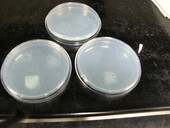Highlight
Investigating the Characteristics of Confined Cellular Systems on the Effectiveness of Ultra-Stable Vaccines for Mycobacterium tuberculosis.
Achievement/Results
Researchers at the University of New Mexico (UNM) are developing highly thermo-stable vaccines for use in the prevention of Mycobacterium tuberculosis (Mtb). Through funding from the NSF’s Integrated Graduate Education and Research Traineeship program on Integrating Nanotechnology with Cell Biology and Neuroscience (INCBN), this interdisciplinary project brings together cell biologists, material scientists, toxicologists, engineers, and physicists in order to solve critical problems regarding world health.
The study focuses on the stabilization of the attenuated vaccine strain of Mtb, which is currently the most widely accepted vaccine candidate. This live cell vaccine requires refrigeration and is highly susceptible to environmental extremes – rendering its distribution expensive and frequently impossible. While this vaccine has been in use for a hundred years, the strain is limited in practicality. A redesigned, more stable vaccine could greatly facilitate vaccination programs worldwide.
Collaboration between the laboratories of Drs. C. Jeff. Brinker in materials science and Graham Timmins in the School of Pharmacy, fostered by the INCBN IGERT program, has developed a novel application of sol-gel processing for the encapsulation of mycobacterium. Cellular confinement within nanostructured silica sol-gel matrices has been demonstrated for yeast and bacteria and has been shown to induce extended viability and a behavior specific to confined systems. The implications of such systems to the treatment of Mtb are twofold: in the first case, a supported live cell vaccine would resist extreme temperatures and obviate refrigeration, thus creating a highly thermo-stable vaccine; additionally, confined mycobacterium can exhibit the characteristics of a dormant Mtb cell, which may lead to the development of a vaccine specific against the latent form of Mtb.
The NSF-funded interdisciplinary team has demonstrated that encapsulated cells stored under dry, heated conditions (37 ºC) for a period of 2 months provide significant protection against infection of mice with an Mtb mutant that exhibits a latent phenotype. Thus, both heat stability (normal vaccine has to be stored at 4 °C) and activity against a latent TB phenotype have been demonstrated. In the near future, proteomic analyses of these systems are planned to further our understanding of cellular dormancy – a topic of high relevance in tuberculosis.
Address Goals
This project is beginning to unveil interesting data regarding the process of confinement on the behavior of individual cells and may elucidate the processes behind cellular dormancy. This research not only seeks to develop a much needed vaccine, but it alludes to the unification of the bio- and the nano- realms, foreshadowing a new era of complex bio-synthetic engineered systems. The biological and material sciences behind the separate aspects of the projects are inherently unrelated and the successful outcome of such a project is only achievable with a highly interdisciplinary assembly of scientists and engineers. NSF is promoting the advancement of not only the current research described above, but also providing tools to broaden the research horizons of dozens of scientists at the University of New Mexico.






